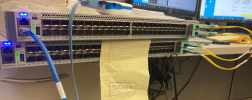HCHTech
Well-Known Member
- Reaction score
- 3,848
- Location
- Pittsburgh, PA - USA
I came across a server today, a fairly recent Dell, with a tantalizingly unused dual-port 100GbE Mellanox card. It has two QSFP28 ports, which are a bit wider than the normal SFP/SFP+ ports I'm used to seeing. This server has a 10GbE connection to the network already, but the switch has a couple of open 25GbE ports, so I'm thinking an easy win is in play here. I could, with the right transceivers and cable, give that server a 25GbE connection to the network, apparently. I'd love to highlight this in my bid to get the business.
In my SMB corner of the world, I haven't run into this fast of a connection before, so I'm wondering if the the QSFP28 ports mean something special, or are they just "what it takes" to get 100GbE. I presume, but will confirm, that they could auto-negotiate down to 25GbE. Fiber is such a pain because you have to match the transceivers on either end to be compatible with the device on that end...
In my SMB corner of the world, I haven't run into this fast of a connection before, so I'm wondering if the the QSFP28 ports mean something special, or are they just "what it takes" to get 100GbE. I presume, but will confirm, that they could auto-negotiate down to 25GbE. Fiber is such a pain because you have to match the transceivers on either end to be compatible with the device on that end...

